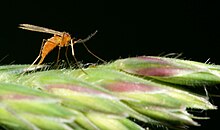
Andricus foecundatrix is a parthenogenetic gall wasp which lays a single egg within a leaf bud, using its ovipositor, to produce a gall known as an oak artichoke gall, oak hop gall, larch-cone gall or hop strobile The gall develops as a chemically induced distortion of leaf axillary or terminal buds on pedunculate oak or sessile oak trees. The larva lives inside a smaller hard casing inside the artichoke and this is released in autumn. The asexual wasp emerges in spring and lays her eggs in the oak catkins. These develop into small oval galls which produce the sexual generation of wasps. A yew artichoke gall caused by the fly Taxomyia taxi also exists, but is unrelated to the oak-borne species. Previous names or synonyms for the species A. fecundator are A. fecundatrix, A. pilosus, A. foecundatrix, A. gemmarum, A. gemmae, A. gemmaequercus, A. gemmaecinaraeformis and A. quercusgemmae.

Rabdophaga rosaria is a gall midge which forms Camellia galls or terminal rosette gall on willow species. It was first described by Hermann Loew in 1850.

Neuroterus albipes is a gall wasp that forms chemically induced leaf galls on oak trees which has both bisexual and agamic generations and therefore forms two distinct galls, the smooth spangle gall and Schenck's gall. Neuroterus laeviusculus and Spathegaster albipes are previous binomials found in the literature.
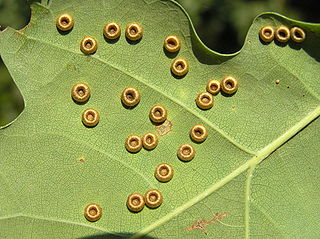
Neuroterus numismalis is a gall wasp that forms chemically induced leaf galls on oak trees. It has both bisexual and agamic (parthenogenetic) generations and forms two distinct galls on oak leaves, the silk button gall and blister gall. The galls can be very numerous with more than a thousand per leaf.

Dasineura crataegi, the hawthorn button-top gall-midge, is a dipteran gall-midge. It causes the hawthorn button-top gall, which develops in the terminal shoots of common hawthorn, Crataegus monogyna Jacq., Midland hawthorn C laevigata (Poir.) DC and their hybrid, C × media Bechst. Synonyms are Perrisia crataegi and Cecidomyia crataegi.
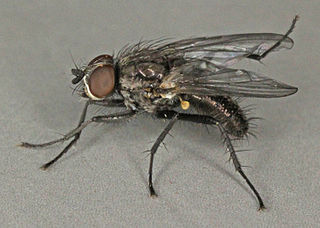
Chirosia betuleti is a species of fly, which causes knotting gall in ferns. The gall develops in the terminal shoots of ferns, such as broad buckler fern, male fern, lady fern, and ostrich fern.
Rabdophaga heterobia is a species of gall midges which has two generations a year and forms galls on almond willow. It was first described by Hermann Loew in 1850.

Rabdophaga salicis is a gall midge which forms galls on sallows. It was first described by Franz von Paula Schrank in 1803.
Rabdophaga justini is a gall midge. It was first described by Horace Francis Barnes in 1935. The larvae tunnel in the shoots of purple willow.
Dasineura auritae is a gall midge which forms galls on the leaves of sallows and their hybrids. It was first described by Ewald Heinrich Rübsaamen in 1916.
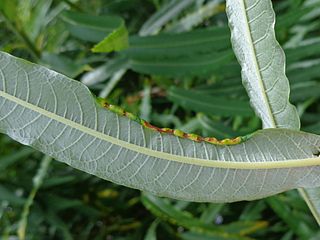
Rabdophaga marginemtorquens is a gall midge which forms galls on willows and is found in Europe. It was described by Johann Jacob Bremi-Wolf in 1847.
Rabdophaga clausilia is a gall midge which, depending on the source, forms galls on the leaves of willows, or is an inquiline living in the galls of a Rabdophaga species, or a predator. It was first described by Johann Jacob Bremi-Wolf in 1847.

Iteomyia major is a gall midge which forms galls on willows. It was first described by Jean-Jacques Kieffer in 1889.

Iteomyia capreae is a gall midge which forms galls on willows. It was first described by Johannes Winnertz in 1853.

Dasineura fraxini is a gall midge which forms galls on the leaves and petioles of ash. It was first described by Johann Jacob Bremi-Wolf in 1847.
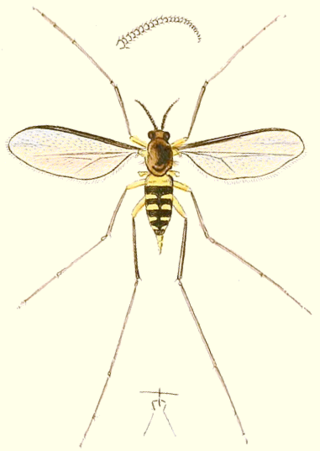
Lasioptera rubi is a species of gall midge in the family Cecidomyiidae and is found in Europe. It was first described in 1803 by the German priest, botanist and entomologist, Franz von Paula Schrank. The larvae feed within the tissue of brambles, creating abnormal plant growths known as galls.
Dasineura plicatrix is a species of gall midge, an insect in the family Cecidomyiidae, found in Europe. It was described by the German entomologist Friedrich Hermann Loew in 1850. The larvae feed within the tissue of bramble leaves, creating an abnormal growth known as a plant gall.
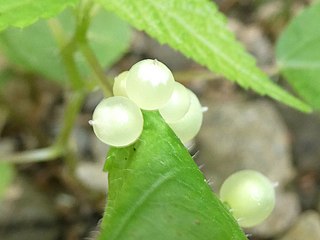
Dasineura investita, the wood nettle gall midge, forms a gall that grows on the wood nettle plant Laportea canadensis It was described in 2016 and is caused by a midge in the family Cecidomyiidae. The galls form on the petiole, upper leaf, leaf midrib, on leaf veins, between leaf veins, flower, stem. They are oval globose 4-5 mm by 8-12 mm pale, red, white, to green translucent.There are two generations a year, the full grown larva from the autumn generation overwinters in the central chamber of the gall. The genus Dasineura is a vary large one with many gall forming species.

Dasineura mali, commonly known as the apple leaf curling midge, apple leaf midge [English], Cécidomyie du pommier [French], Appelbladgalmug [Dutch], or Apfelblattgallen [German],is a species of gall midge belonging to the family Cecidomyiidae, within the order Diptera.


